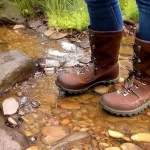In a world increasingly prioritizing comfort‚ durability‚ and a rugged aesthetic‚ a fascinating question emerges from the dusty trails and into our bustling cities: Can our beloved hiking boots truly serve as everyday footwear? Once reserved exclusively for scaling jagged peaks or navigating dense forests‚ these formidable foot guardians are now making an unexpected‚ yet undeniably stylish‚ appearance on city streets‚ in offices‚ and even at casual social gatherings. This intriguing shift prompts us to reconsider not just our footwear choices‚ but also our evolving relationship with practicality and personal style in the twenty-first century.
The allure is palpable: the promise of unparalleled support‚ weather resistance‚ and a sartorial statement that speaks to adventure and resilience. Modern life‚ with its unpredictable commutes and diverse demands‚ often feels like an expedition in itself‚ requiring gear that can withstand more than just the occasional weekend trek. But is this daily devotion to our trail companions a brilliant adaptation or a potential misstep for our foot health and long-term comfort? Let’s meticulously explore the multifaceted implications‚ weighing the undeniable benefits against the subtle‚ often overlooked‚ drawbacks of embracing hiking boots as our constant companions.
| Aspect | Description / Impact | Recommendation / Best Practice |
|---|---|---|
| Foot Health & Support | Excellent ankle and arch support‚ crucial for varied terrains. However‚ excessive stiffness can restrict natural foot movement over long periods on flat surfaces‚ potentially leading to muscle weakness or discomfort. | Opt for boots with flexible forefoot and ample toe box. Consider custom orthotics if needed. Alternate with other footwear to allow feet to move naturally. |
| Durability & Longevity | Built to withstand harsh environments‚ offering superior protection against wear and tear compared to typical street shoes. The robust construction ensures a longer lifespan‚ often justifying a higher initial investment. | Regular cleaning and conditioning of leather or synthetic materials. Resole when necessary. Rotate between multiple pairs to extend their life. |
| Comfort & Weight | While supportive‚ many hiking boots are heavier and less breathable than casual shoes. This can lead to fatigue‚ excessive sweating‚ and a feeling of bulkiness during prolonged urban wear. | Choose lightweight‚ modern hiking boots designed with advanced materials. Prioritize boots with excellent ventilation. Select appropriate socks (wool or synthetic) to manage moisture. |
| Traction & Sole Wear | Aggressive outsoles provide exceptional grip on uneven‚ slippery trails. On hard‚ flat urban surfaces like concrete and asphalt‚ these lugs can wear down quickly and may feel less stable‚ potentially leading to premature sole degradation. | Look for boots with a less aggressive tread pattern or those featuring Vibram Megagrip or similar compounds optimized for mixed terrain. Be mindful of slip hazards on polished indoor floors. |
| Style & Versatility | The ‘gorpcore’ trend has normalized hiking boots in fashion. They offer a distinct‚ rugged aesthetic. However‚ they might not seamlessly integrate with all professional or formal attire‚ potentially limiting wardrobe versatility. | Pair with appropriate casual or business-casual outfits. Choose models with cleaner lines and muted colors for broader applicability. Embrace them as a statement piece. |
The modern hiking boot has evolved dramatically from its clunky ancestors. Today’s iterations are often engineering marvels‚ meticulously crafted from advanced materials like Gore-Tex for waterproofing and Vibram for superior sole grip. “The innovation in footwear technology over the past decade has been astounding‚” observes Dr. Elena Petrova‚ a leading biomechanics expert specializing in athletic footwear. “Manufacturers are now producing boots that offer an incredible blend of lightweight construction‚ robust support‚ and surprising breathability‚ effectively blurring the lines between specialized outdoor gear and everyday practical wear.” This technological leap empowers wearers to enjoy the benefits of rugged protection without the historical burden of excessive weight or discomfort‚ making the proposition of daily use far more appealing.
However‚ the transition from mountain path to pavement is not without its nuances. While hiking boots excel at providing stability on uneven ground‚ the unyielding flatness of urban sidewalks can present a different set of challenges. “Constant walking on hard‚ flat surfaces in overly stiff footwear can actually inhibit the natural movement of the foot’s intrinsic muscles‚” cautions Dr. Marcus Thorne‚ a renowned podiatrist. “Over time‚ this might lead to a weakening of these crucial muscles‚ potentially contributing to issues like plantar fasciitis or arch pain. It’s a classic case of too much of a good thing.” Therefore‚ selecting boots with a degree of flexibility in the forefoot‚ allowing for a more natural toe-off‚ becomes incredibly important for those committed to daily wear.
Furthermore‚ the aggressive tread patterns designed for maximum traction on loose dirt and slippery rocks can experience accelerated wear when subjected to the abrasive forces of concrete and asphalt. This premature degradation not only shortens the lifespan of the boot but can also diminish its intended performance when you do return to the trails. Savvy consumers are increasingly opting for models featuring outsoles specifically engineered for hybrid use‚ balancing trail-ready grip with urban durability. Companies like Merrell and Salomon are pioneering designs that integrate advanced rubber compounds‚ offering remarkable longevity across diverse terrains‚ thereby extending the practical application of these versatile boots.
For those determined to make their hiking boots a daily staple‚ a proactive approach is key. Investing in high-quality insoles can significantly enhance comfort and provide customized arch support‚ mitigating some of the risks associated with prolonged wear on flat surfaces. Equally important is the practice of footwear rotation. By alternating between your hiking boots and other supportive‚ breathable shoes‚ you allow your feet to engage different muscle groups and recover‚ preventing overuse injuries and extending the life of your entire footwear collection. This mindful strategy transforms the choice from a simple ‘yes’ or ‘no’ into a sophisticated ‘how’ – how to integrate robust functionality into your everyday life harmoniously.
Ultimately‚ the question of whether you can wear hiking boots everyday isn’t merely about feasibility; it’s about embracing a lifestyle that values resilience‚ preparedness‚ and comfort without sacrificing style. By carefully selecting modern‚ adaptable models‚ understanding their inherent characteristics‚ and adopting smart usage practices‚ your trusted hiking boots can indeed become an incredibly versatile and enduring cornerstone of your daily wardrobe. They represent more than just footwear; they embody a forward-looking perspective‚ empowering you to navigate life’s varied landscapes‚ both wild and urban‚ with unwavering confidence and support.






